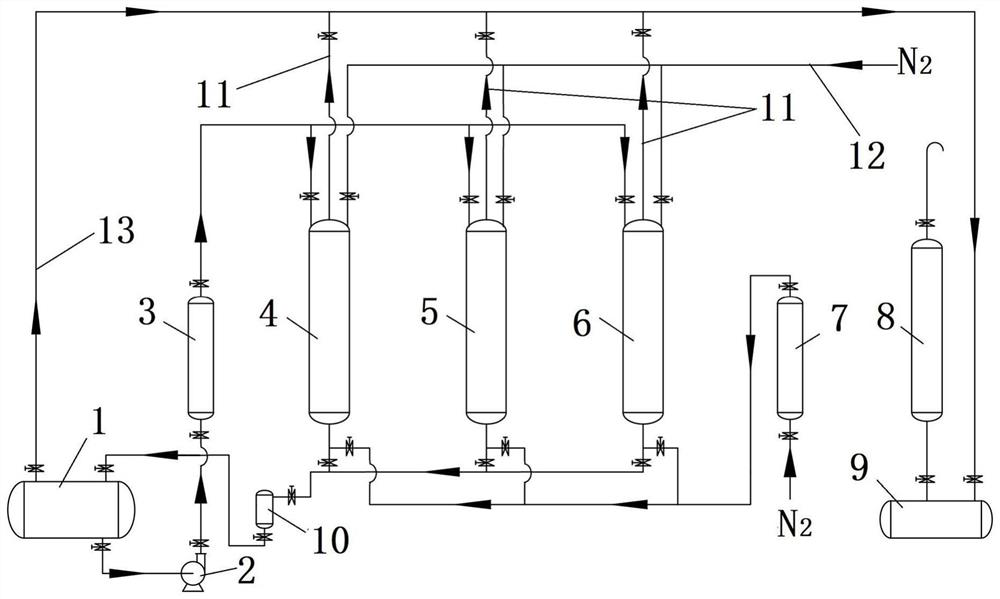Industrialized organic solvent deep dehydration method
An organic solvent, deep dehydration technology, applied in the field of chemical solvent water removal, can solve problems such as high cost, and achieve the effect of ensuring purity, avoiding deterioration and continuous dehydration
- Summary
- Abstract
- Description
- Claims
- Application Information
AI Technical Summary
Problems solved by technology
Method used
Image
Examples
Embodiment 1
[0046] Example 1: according to the attached figure 1 As shown in the process flow, the solvent storage tank 1 contains 5000L of organic solvent, the initial moisture of the solvent is between 0.60-0.50%, the inner diameter of molecular sieve drying tower I4, molecular sieve drying tower II5 and molecular sieve drying tower III6 are all 500mm, and the filling height of molecular sieve is 5000mm. , the solvent circulation volume is 30m 3 / h.
[0047] A. The solvent cooler does not pass refrigerant, and the circulating solvent does not cool down. The organic solvent is only circulated through the molecular sieve drying tower 4. Compare this with the dehydration process with refrigerant added.
[0048] After the first batch of 5000L organic solvent was circulated for 90 minutes, the moisture content of the organic solvent was reduced to 0.011%, and the temperature was 32°C;
[0049] After the second batch of 5000L organic solvent was circulated for 90min, the moisture content ...
Embodiment 2
[0066] Example 2: according to the attached figure 1 As shown in the process flow, 5000L of organic solvent is injected into solvent tank 1, the initial moisture of the solvent is between 0.60-0.50%, the inner diameter of molecular sieve drying tower I4, molecular sieve drying tower II5 and molecular sieve drying tower III6 are all 500mm, and the filling height of molecular sieve is 5000mm. The organic solvent circulation volume is 30m3 / h.
[0067] In Example 1, the molecular sieve drying tower II5 of Example B is used as the first-stage dehydration tower. Molecular sieve drying tower III6 is used as the second-stage dehydration tower, and is operated according to Example B in the embodiment, and 11 batches of organic solvents are recycled and dehydrated, and the final moisture of the 11th batch of solvents is 0.027%. At the same time, the molecular sieve drying tower I4 is fed with heated nitrogen for stripping and regeneration. Control the temperature of nitrogen gas into ...
Embodiment 3
[0071] Example 3: In Example 2, the molecular sieve drying tower I4 was used as the first-stage drying tower, and the molecular sieve drying tower II5 was regenerated under the following conditions and used as the second-stage regeneration drying tower.
[0072] Molecular sieve drying tower II5 regeneration conditions: temperature after nitrogen preheating: 120-130 °C; molecular sieve drying tower II5 internal temperature control: 120-130 °C; use nitrogen heater to heat nitrogen and pass it into molecular sieve drying tower II5, and use hot nitrogen to blow De-regeneration for 32h, followed by cooling with cold nitrogen for 3h.
[0073] Attached figure 1 As shown in the process flow, there is 5000L of organic solvent in the solvent storage tank 1, the initial moisture of the organic solvent is between 0.60-0.50%, the inner diameter of the molecular sieve drying tower I4, molecular sieve drying tower II5 and molecular sieve drying tower III6 are all 500mm, and the molecular sie...
PUM
 Login to View More
Login to View More Abstract
Description
Claims
Application Information
 Login to View More
Login to View More - R&D
- Intellectual Property
- Life Sciences
- Materials
- Tech Scout
- Unparalleled Data Quality
- Higher Quality Content
- 60% Fewer Hallucinations
Browse by: Latest US Patents, China's latest patents, Technical Efficacy Thesaurus, Application Domain, Technology Topic, Popular Technical Reports.
© 2025 PatSnap. All rights reserved.Legal|Privacy policy|Modern Slavery Act Transparency Statement|Sitemap|About US| Contact US: help@patsnap.com

